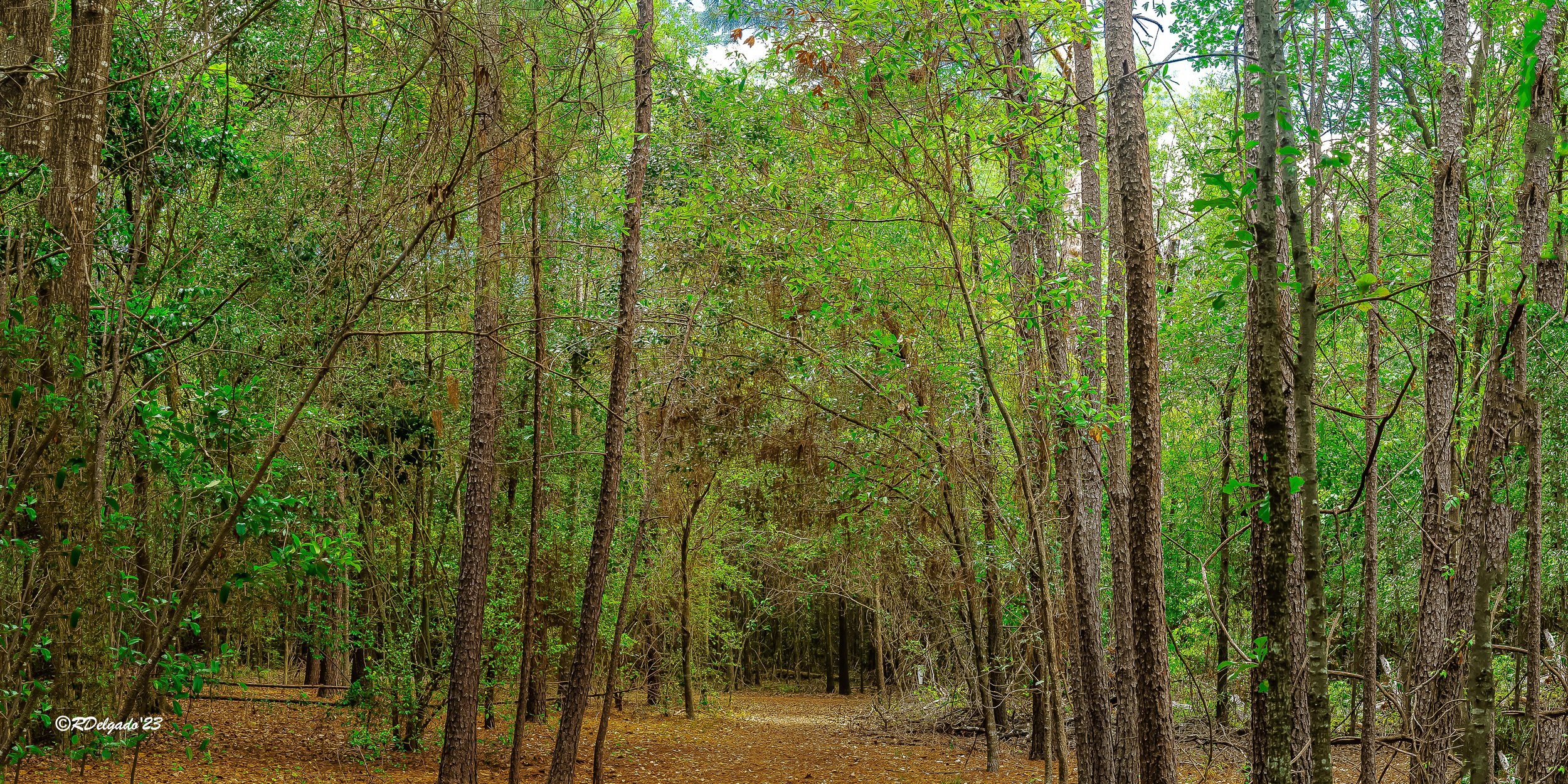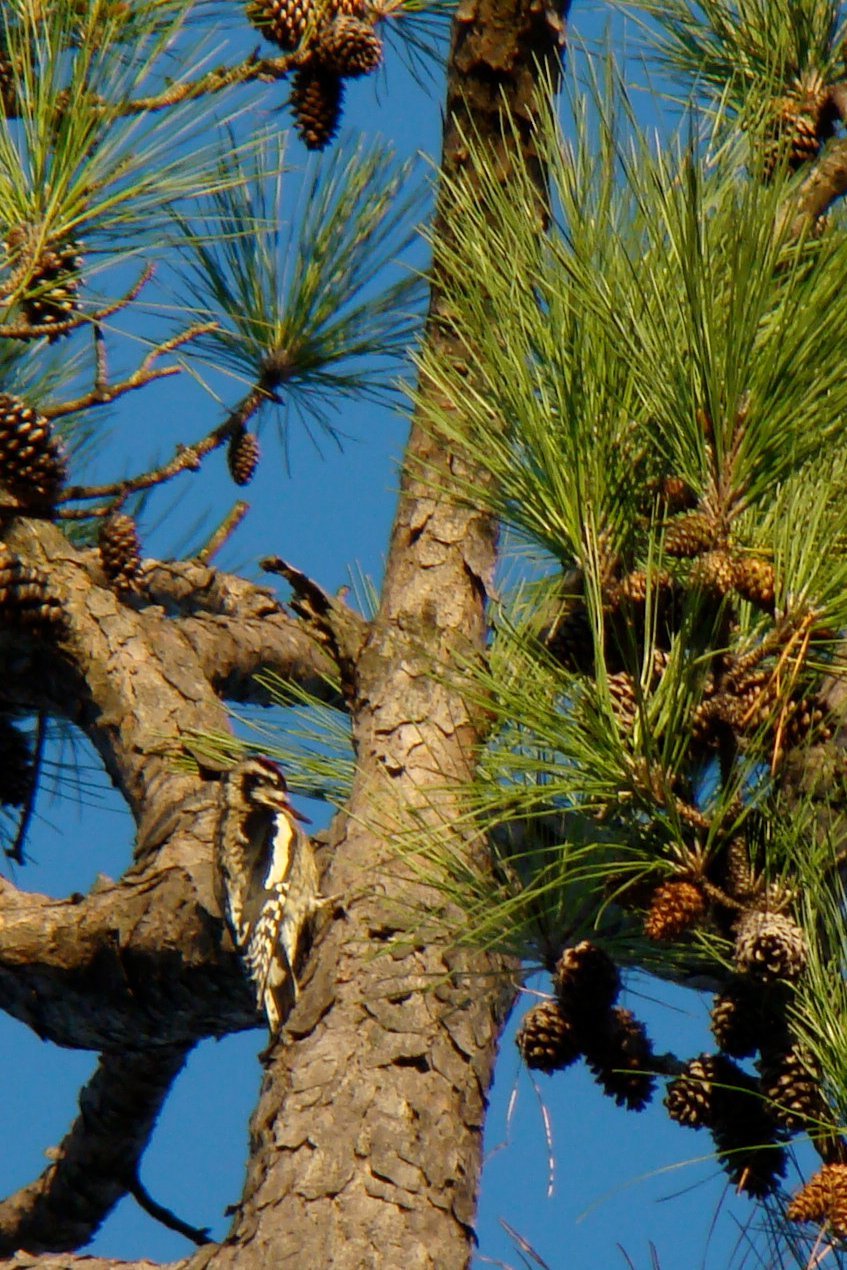The forest changes
Before the droughts of 1980 and 2011, the forest in The Lorraine Cherry Nature Preserve was known for the 100-year-old Loblolly Pines that shaded the entire area. These tall trees were a significant factor in controlling the climate of the forest, affecting what could grow underneath and how fast it could grow. Prior to the drought, they were the main trees growing here in the forest.
Photo by Robert Delgado. Typical entrance into TLCNP.
Those pine trees used a strategy called “allelopathy” to discourage anything else from growing around them and competing for the available resources. Allelopathy is a common biological phenomenon by which one organism produces biochemicals that influence the growth, survival, development, and reproduction of other organisms. These biochemicals are known as allelochemicals and can have either a beneficial or detrimental effect on target organisms. Another familiar plant that uses allelopathy is the sunflower.
But now, as a result of the droughts, many of the tall trees are gone, and the forest is changing into something very different. There are now other trees among the pines, including many types of Oaks, Elms, Ashes, and even Sweet Gums. These once smaller trees have big, light-gathering leaves that helped them survive in shaded areas. They did not grow very big when the larger pine trees towered over them because they didn’t get enough light and had to struggle to get nutrients. But under the ground, they grew a foundation of roots, ready to start growing tall if anything happened to the pine trees above them. Now the light is getting through.
Photo by Robert Delgado. Typical trail within TLCNP.
Today, more than 38 native species of trees can be seen in The Lorraine Cherry Nature Preserve which attract many migratory animals throughout the year.
Click here to learn more about the Trees of Texas
Click here to see TLCNP Guided Tree Walk.
Below are some of the native trees that can be seen at TLCNP. Click on name for additional information.
Black Cherry Tree
Black Cherry
A large native tree to 80 feet tall and a trunk 1 to 3 feet in diameter. Often seen with long clear trunks with little taper and an oval crown.
This tree is common in East Texas woods. Fragrant white flowers will appear with new leaves in the spring. The flowers will attract the Eastern Tiger Swallowtail for nectar. Later both Eastern Tiger Swallowtail and Hairstreak butterflies will lay eggs on top of the Black Cherry leaves.
The berry fruit is 1/2 inch diameter wide in long, hanging clusters. The purple color berries ripen in late summer.
Green Ash Leaves
Green Ash
This deciduous tree is found all over North America from Canada to southeastern Texas, especially in the swampy bayou region around Houston. The Green Ash tree has spreading branches and an oval crown shape. Here in Texas, this fast-growing tree can grow to be 75 feet tall and its bright green leaves will turn purple or yellow in the fall. Because of its strength, hardness, and high shock resistance qualities, ash is used to make flooring, boxes & crates, and turned objects such as tool handles or boating oars. It is also sometimes used to make baseball bats, although they are more typically made out of the closely related White Ash.
The Green Ash acts as a host plant for the Eastern Swallowtail Butterfly and Polyphemus Moths.
Hackbeery Tree trunk
Hackberry
A medium to large deciduous tree, becoming 50 feet or more tall and 2 feet or more in diameter, with a round or oval crown and limbs that often end in slender, drooping branches and a relative of the Elm.
This tree often has a warty tree trunk. The warts on the bark are not signs of disease. Rather, they are part of the normal appearance for these trees and may provide some protection for the thin, fragile bark.
The Hackberry provides food for a wide range of organisms. In early spring white blooms will appear. The dull, red berries that appear in early fall are a favorite of birds and squirrels. In particular, the Hackberry is a host plant for butterflies, including the Hackberry Emperor and the Tawny Emperor.
Hercules Club tree trunk @ TLCNP.
Hercules Club
A small deciduous tree, seldom over 40 feet in height, that is easily identified at a distance by the large, knobby warts on the trunk and branches. The tree is also called the Toothache Tree or Tickle Tongue Tree, because the bark and leaves contain a chemical compound that produces a numbing sensation in the mouth. Native Americans and early settlers used the leaves as a remedy for toothaches, and mothers would rub their baby’s gums with the leaves to soothe the pain of teething.
The Hercules Club tree‘s flower attracts many bees, including the Sweat Bee. Since this tree is a member of the citrus family, the leaves are a preferred food for caterpillars of the Giant Swallowtail Butterfly.
Loblolly Pine
This evergreen is a large, fast-growing tree of forests and abandoned fields, reaching heights of 125 feet and a trunk to 4 feet in diameter, with a dense, rounded crown of dark, blue-green foliage.
Its range is East Texas, as far west to the "Lost Pine" region in the vicinity of Bastrop, Lee, and Fayette counties. Loblolly pine was most commonly found along banks of streams in virgin forests of Texas, but is now the dominant pine on all sites.
Their leaves are needles borne in bundles of 3, mostly 5" to 10" long, and dull blue-green; in the spring, bright green clumps of needles grow at the end of branches and give the tree a luxuriant appearance.
Sweet Gum
This large deciduous forest tree grows to 100 feet tall or more and a straight trunk to 3 feet or more in diameter, with a conical shape when young and an upright, broad crown on older trees.
You will find this tree in East Texas on rich river bottom soils, in swamps subject to frequent flooding, and dry uplands, as far west as the San Jacinto river basin.
This tree is easy to identify due to it’s simple, alternate, star-shaped, 4" to 7" long and wide, with 5 to 7 pointed lobes and a finely-toothed leaf margin. Leaves are aromatic when crushed and turn brilliant colors of yellow, orange, red, and purple in the fall.
Winged Elm Tree Trunk
Winged Elm
The Winged Elm, also called Cork Elm, Wahoo Elm, or Witch Elm, is one of our native trees, growing 40 ft. high with spreading branches that form a round-topped, vase-shaped head.
The leaves may turn yellow in fall. The leaves alternate down the branch, and are ovate, oblique, doubly serrated and 2-4 long by 1-2 inches wide. It blooms in February, March, and April. It makes a brown fruit called a samara.
Interesting fact, early settlers used the inner bark of this tree to fashion a coarse rope.









